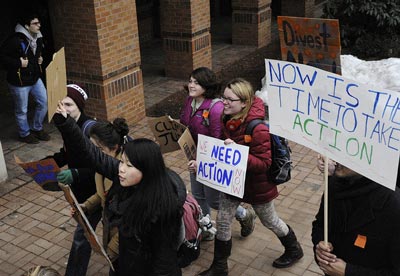
Stanford University student Erica Knox went to see Bill McKibben’s “Do the Math” tour in November 2012. That’s when McKibben and 350.org launched a divestment movement to address climate change and challenge the power of the fossil fuel industry. Knox has been involved with divestment group Fossil Free Stanford ever since. “It’s definitely the group on campus where I feel like I’m actually creating change,” she said.
Modeled after the anti-apartheid movement of the 1970s and ’80s, the divestment campaign pressures universities and other institutions to sell their stock in fossil fuel companies. The movement has spread to more than 300 schools nationwide, as well as cities and faith-based institutions. San Francisco and Seattle, churches including the United Church of Christ, and small colleges such as Hampshire and Pitzer have already pledged to divest.
Divestment is just one strategy to combat climate change, says Knox, who is majoring in earth systems. But she says Stanford students can use their connection to the university’s $18.7 billion endowment to make a strong statement. “It’s important for us while we’re at a university with this kind of power and privilege to leverage that to actually make a difference.”
Divestment is nothing new to Donald Kennedy. While he was serving as president of Stanford in the 1980s, the university divested from specific companies that supported the apartheid regime in South Africa. Now, the former president and current Bing Professor of Environmental Science and Policy is supporting the university’s decision to begin divesting from coal-mining companies.
Kennedy was one of 170 tenured professors who signed a letter addressed to President Hennessy and the Board of Trustees. The letter, which followed a university-wide divestment petition that gathered nearly 2,000 signatures, called for Stanford to divest from all fossil fuels, including coal, oil, and natural gas. As President Emeritus, Kennedy’s was one of the most prominent names supporting the request to divest.
Kennedy, whose research interests include global climate change, believes coal divestment is valid, as there are alternative fuels that could be substituted for coal. He hopes there will be “careful and thoughtful analysis of what might be done elsewhere in order to promote a more effective set of climate policies.” He’s in favor of actions like divestment that encourage companies to pursue “a more controlled approach to the very serious problem of climate change.”
Amy Tomasso, a Stanford urban studies major from Farmington, Conn., was drawn to Fossil Free Stanford’s focus on student activism and the momentum that divestment was gaining on campus.
Last year, the group met with the university’s Advisory Panel on Investment Responsibility and Licensing to request divestment from the top 200 fossil fuel companies. After months of review, Stanford’s Board of Trustees announced on May 6, 2014, that it had agreed to begin divesting its stock in coal-mining companies.
The announcement, which came sooner than expected, was a surprise to Tomasso and other activists on campus. It positioned Stanford as the first major university to make a commitment to divest from coal. Fossil Free Stanford organizers celebrated their victory while planning to push for divestment from all fossil fuels, including oil and natural gas. Tomasso says it’s important for young people to lead the fight for fossil fuel divestment because they’re the first generation who’ll be living through the consequences of climate change.
“Everyone can be an activist,” says Tomasso. “Everyone has things they care about and love. If you take a moment to think about them, you’ll realize that the call to action is now.”
Angry, shocked, overwhelmed? Take action: Support independent media.
We’ve borne witness to a chaotic first few months in Trump’s presidency.
Over the last months, each executive order has delivered shock and bewilderment — a core part of a strategy to make the right-wing turn feel inevitable and overwhelming. But, as organizer Sandra Avalos implored us to remember in Truthout last November, “Together, we are more powerful than Trump.”
Indeed, the Trump administration is pushing through executive orders, but — as we’ve reported at Truthout — many are in legal limbo and face court challenges from unions and civil rights groups. Efforts to quash anti-racist teaching and DEI programs are stalled by education faculty, staff, and students refusing to comply. And communities across the country are coming together to raise the alarm on ICE raids, inform neighbors of their civil rights, and protect each other in moving shows of solidarity.
It will be a long fight ahead. And as nonprofit movement media, Truthout plans to be there documenting and uplifting resistance.
As we undertake this life-sustaining work, we appeal for your support. Please, if you find value in what we do, join our community of sustainers by making a monthly or one-time gift.